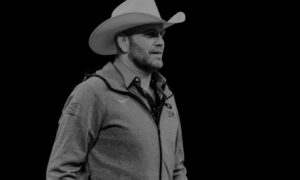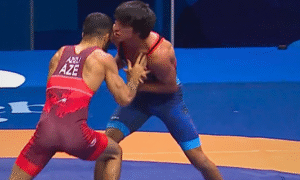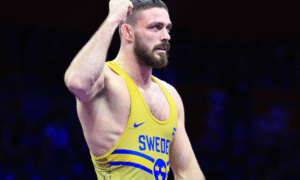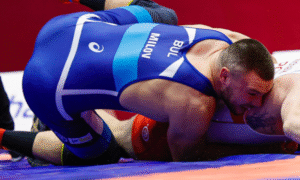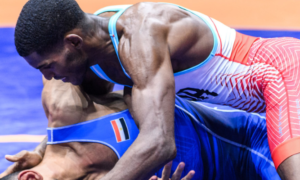The first line of thinking for most Greco-Roman fans pertaining to this weight class is probably something like, Oh, well Lopez isn’t there. It’s true. Five-time World Champion and three-time Olympic gold medalist Mijain Lopez (CUB, world no. 1) is not competing in Paris and his absence will surely be missed. But so what? Sure, it would be interesting to see Lopez perform a year after Rio at 35 years of age and to gauge whether or not he’s still got it. It’s just that his presence is certainly not mandatory.
Riza Kayaalp (TUR, world no. 2) and Sergey Semenov (RUS, world no. 3) bring their own star power to 130 kilograms and lead a field consisting of many talented former age-group studs who are hungry for their own chances to shine. There are a few wrestlers here riding hot streaks, like Levan Arabuli (GEO, world no. 4) and Yasmani Acosta Fernandez (CHI, world no. 17). There are also some steady competitors who have shown that they have what it takes to enter into the medal argument after putting together outstanding careers, such as Germany’s Eduard Popp and the United States’ Robby Smith (NYAC).
Smith, who has come close to medaling at the World Championships twice before, is on the back nine of his incredible journey atop the ladder in the US. But that does not in any way mean he is slowing down. Following the Rio Olympics, Smith was forced to take time off to heal from surgery on his wrist. He returned in March and immediately made an impact, winning the Thor Masters Invitational in Denmark. A month and half later, he went on to secure his fourth US World Team spot with back-to-back victories over Toby Erickson (Army/WCAP). As one of the most athletic and hyper-competitive talents at 130 kilos, Smith is very much someone all of the other guys here will be reluctant to do battle with.
No World tournament is complete without a bevy of bruising heavyweights to anchor down the proceedings. You’ve got that here and then some.
2017 Greco-Roman World Championships: 130 kg
Sergey Semenov — RUS, world no. 3 (2016 Olympic bronze medalist, two-time Junior World Champion, 2015 Junior World bronze medalist, 2015 U23 European Championships gold medalist, two-time Russian Nationals gold medalist)
Semenov is the second-most credentialed wrestler in this bracket (which is obviously, mind-boggling), but he is one of the best overall “wrestling athletes” at 130, at least this year. His body simply knows how to wrestle, the knowledge embedded deep into his cells. Semenov is no plodder; he is active and engaged constantly, going to a two-on-one and coming across for short drags so he can wrap around the body. Or for those special occasions, he can break out a pretty wicked snap that catches opponents off-guard. Add into the mix that he is incredibly effective when he has chances on top, and what you have is a complete package more than capable of winning. Weight class favorite and #1 seed Riza Kayaalp (listed below) defeated Semenov two years ago at the European Games, but this is a different day. If/when they meet in Paris, that should be evident.
Levan Arabuli — GEO, world no. 4 (2017 European Championships bronze medalist, 2017 Hungarian Grand Prix gold medalist)
It’s reasonable to say that Arabuli is more of an undercover threat here. It has been a steam-gathering proposition for the 25-year-old. Georgia’s Junior star Zviadi Pataridze (world no. 12) slipped past him at the Ukrainian International event in March; a few weeks later, Arabuli bounced back and made the finals of the Hungarian Grand Prix where he upended Tuomas Lahti (listed below). That set Arabuli up for the European Championships. In the quarters, he and Kayaalp threw down in what was a tactical, slow-paced bout which saw the Turkish wrestler emerge with a 3-1 victory. Arabuli dusted himself off for the bronze medal bout and then proceeded to beat up on Christian John (GER). And then last month, the Georgian managed to come away as the winner of a particularly stacked field at the Pytlasinski Cup. Suffice it to say, if you believe there is such a thing as momentum in wrestling, Arabuli is your guy.
Riza Kayaalp — TUR, world no. 2 (Two-time World Champion, 2016 Olympic silver medalist, 2012 Olympic bronze medalist, two-time Junior World Champion, two-time World silver medalist, two-time World bronze medalist, 2007 Junior World silver medalist)
The accolades are amazing, the career is Hall of Fame-worthy, and at 27, he has another quad in him — yikes. Everyone at 130 kilograms knows the deal. With Lopez’s absence, Kayaalp is the unquestioned favorite. However — there is also another absence for this event that plays a role: forced par terre. Par terre helped turn Kayaalp into a star and while he has been successful thus far without it, he is certainly not able to pile up points the same way. He has compensated for this issue by demanding more action in the pocket. Kayaalp is still winning matches, close and otherwise, by trucking forward and off-balancing foes whenever the tie-ups veer in his favor. He’s a big kid, but there is a compactness to his frame that allows him to find leverage when others can’t. Past success at the World Championships is important and there is no one else here who rivals Kayaalp in this regard. He is intimately comfortable with the environment. As such, there is just too much going on with him to think he won’t be gunning for another title by the end.
Balint Lam — HUN, world no. 5 (2012 Junior World Champion, two-time University World Champion, 2017 European Championships silver medalist)
Extremely tall and lanky, Lam is an awkward dude to deal with. It’s all arms and legs, he’s like a giant spider. Fortunately for him, he is also pretty strong. Similar to how Kayaalp brings a ton of density to the table and is able to gain leverage against bigger guys, Lam uses his considerable stature to dominate head position. He’ll pull, snap, and even grab a collar tie if someone is convinced that reaching up is a good idea against him (it’s usually not). Speaking of Kayaalp, these two battled it out in the finals of the European Championships and Lam did a great job of delivering pressure over the top on occasion, noteworthy if only because Kayaalp is not one to back up very often. He still dropped the match, but a solid performance it was.
Alin Alexuc-Ciurariu — ROU, world no. 6 (2010 Junior World silver medalist, 2015 FILA Grand Prix bronze medalist, 2017 Ljubomir Ivanovic Gedza International gold medalist)
Alexuc-Ciurariu is probably not seen as a major contender for a medal on Tuesday, so let’s get that out of the way. It doesn’t mean he can’t or won’t be, but the perception surrounding the Romanian is that the top guys here will still find a way to shut him down when it counts. That might be a mistake. If Alexuc-Ciurariu has shown anything, it is that he has a habit of making any match with him an unpleasant experience. He’s got that edge. He won’t be bullied and is not above roughing things up inside to send a message. Lam was able to use his size in spaces at the Euros to stop Alexuc-Ciurariu from gaining meaningful tie-ups, but that is a path to victory for everyone. Alexuc-Ciurariu had some good prep for the Worlds, winning the Gedza International before flunking out of Pytlasinski. His last time out was a silver medal-performance at the Ion Corneanu & Ladislau Simon Memorial, falling to Yasmani Acosta Fernandez (CHI) in the finals.
Eduard Popp — GER (2016 Olympian, 2010 Junior World bronze medalist, 2016 World Military Championships silver medalist, 2016 Thor Masters Invitational gold medalist)
There’s no doubt about it, Popp should have more buzz surrounding his participation here, but his forays into other competitive avenues have distracted the masses. That, and the fact that he hasn’t delivered big performances in his last two events, the World Cup and the Pytlasinski Open, respectively. Ridiculous. Popp is an outstanding wrestler who is in his prime. He has also been in the hunt for a bronze before, including at last year’s Olympiad, where he dropped a frustrating bout to Sabah Shariati (AZE, world no. 7). In July’s Pytlasinski Cup, Popp brought the heat against Arabuli but wore down towards the end of both periods. He was then defeated in the repechage by Lam, ending his bid for bronze. Despite not having put together a string of medal-winning outings following Rio, Popp should still be considered a sleeper pick to advance if his draw is at all decent.
Mantas Knystautas — LTU, world no. 15 (2014 Junior World silver medalist, 2017 U23 European Championships silver medalist, 2016 U23 European Championships bronze medalist, 2016 Haavisto Cup silver medalist, 2017 Nordic Championships gold medalist)
Here’s what you like about Knystautas — he loves getting to the body. Oh, it’s a sight to see. There are times when Knystautas has literally tried to chase down opponents with his arms outstretched, like a grandparent ambling after a toddler. If he can wrap, he wraps. Obviously, this isn’t so easy. Guys push off, they angle into different tie-ups, hold wrists, twist fingers, back up… No one wants to get thrown. The problem is that Knystautas lacks nuance in the complementary areas which lead to such bodylock opportunities. There is virtually no pretense to him. He doggedly pressures in constantly. But there is an element of inconsistency in his game. Knystautas will either be totally open or completely closed up, and that limits his options. But if you are itching to find a wrestler here who is at best, exciting, and at worst, interesting, keep an eye on him. So long as he has a willing partner, his matches are worth the price of admission.
TEAM USA: Robby Smith (2015 Pan Am Championships gold medalist, two-time Pan Am Championships silver medalist, three-time NYAC International Open gold medalist, 2017 Thor Masters Invitational gold medalist)
One of the most popular wrestlers in the US, Smith became a cult hero after his bronze medal bout with Bilyal Mahkov (RUS) at the 2015 Worlds in Las Vegas. Down by seven points, Smith stormed back into the thick of things with a beautiful bodylock right at the end of the first period. Mahkov picked up a couple points in the second before Smith trucked him to his back for four more, nearly decking the statuesque Russian on the spot. Smith lost the match 10-8, but won the crowd, and most importantly, qualified 130 kilos for Rio.
Smith just about breezed through the Olympic Trials seven months later, brushing past Michigan’s Adam Coon in two straight to sew up his spot. The Californian entered the Olympics as a very serious medal candidate with two fifth place finishes at the Worlds under his belt (2013, 2015) to go along with a litany of other notable wins both domestically and internationally. His draw was a toughie in eventual bronze medalist Shariati, though Smith held a 2-0 lead in the second period when the officials decided it was his turn to pay the piper. He was dinged twice in :30 for passivity, which was pretty much a travesty considering his work-rate. Shariati took advantage of his good fortune and gutted Smith over a few times for bitter-tasting 8-2 defeat of the American.
It wasn’t a crossroads moment for Smith, not really. He knew he still wanted to continue on once he returned home. But there was significant turnover elsewhere for the US with the dawn of a new quad. Both Harry Lester and Andy Bisek retired, taking their two World bronzes apiece with them. So too did lightweight legend Spenser Mango, and multiple-time World Team member Jordan Holm, and Jake Fisher. They all waved goodbye to competition, leaving a perceived void. With the US program still in need of veteran leadership, the responsibility fell to Cheney Haight and Smith, who was already recognized as the captain of the squad. It was going to be a minute, though. Smith, 30, required surgery on his wrist and the proceeding recovery didn’t take place overnight. It wouldn’t be until early-2017 when he finally stepped on a mat again.
March’s Thor Masters Invitational, the annual Nordic event that offers a pool-system format, was the perfect place for Smith to get himself back into game shape. No matter what, he was going to get some matches in. Thing was, he really made them count. A first-round decision loss to Oscar Marvik (NOR) wound up being just a hiccup, for Smith then went on a four-match win streak that included a victory over former teammate and domestic rival Toby Erickson (Army/WCAP). It all added up to an overseas gold and any doubts US fans had regarding Smith’s ability, both physically and competitively, were eliminated, at least for the moment. It wasn’t just that he won, although that played a big role in helping assure coaches and fans that he was still as viable as ever. It was how he looked. Smith was opportunistic, aggressive, and as much of pit-fighter as you need to see. The balance, the arm throw, the front head, the pummeling…there was nothing missing from his game and when you take into account he had just gotten over a high ankle sprain, his showing at Thor Masters becomes all-the-more-remarkable.
The World Team Trials had a different feel for Smith in 2017. He was certainly seen by most, if not all, serious observers of the sport as the odds-on favorite. However, there was still enough of a whisper regarding his future to deploy the perception that either Erickson or even up-and-coming Jacob Mitchell (Army/WCAP) could potentially knock him off. That would indeed not be the case. Far from it. Smith did give up offensive points to Eric Fader (Marines) in his first bout, which was only the second time on US soil in several years such an incident occurred. But he responded with a flourish, decking Fader shortly thereafter with a headlock. Next, he orchestrated a complete shutdown against Michell, zeroing him out 7-0. That set Smith up with Erickson yet again. The pair had met previously in a couple major finals, Smith emerging victorious each time. The pattern stayed the same. A close first bout in the best-of-three series went Smith’s way, but he wanted to leave an even stronger impression on the Vegas crowd. He did that and more in the second round, tossing Erickson to his back and circling around to come away with a fall, his second of the tournament.
At the Pan Ams in Brazil the very next week, Oscar Pino Hinds (listed below) was able to secure a short throw on Smith for four points early in their semifinal bout to snag a 4-0 lead. Smith scored a late takedown to cut the deficit in half, but eventually dropped the match 4-2 to the Cuban. For bronze, Smith latched on a front headlock, one of the go-to moves in his arsenal, and quickly tech’ed out Josue Encarnacion Ovando (DOM).
Smith, along with most of the 2017 US World Team, competed at the Tbilisi Grand Prix in Tbilisi, Georgia in early-June. The event is lauded for its significant number of accomplished international competitors, particularly from Eastern Europe. Team USA, in the midst of its training cycle for the Paris World Championships, saw it largely as a test event, a mechanism to discern where certain athletes were at in their preparation and what adjustments needed to be made ahead of August. That did very little to temper Smith’s enthusiasm for the competition. He approached his match with decorated Belarusian monster Iosef Chugoshvili looking to make a statement and for a while, it was working. He was out-hustling Chugoshvili in every exchange and gaining ground in the tie-ups. It was enough to net him a 1-0 passivity lead early on. Chugoshvili was then hit for a caution-and-two for grabbing fingers and Smith was out in front 3-0. In the second period and controlling the pace while holding a 3-1 edge, Smith took a risk that didn’t pay off. He had went high on a front headlock, lifting Chugsoshvili ever-so-slightly off the tarp. The Belarusian had a wide-open lane to nab a bodylock, which he did, and converted it for four points and a 5-3 lead, which is how the match ended.
That was actually good to see. Encouraging, even. Chugoshvili, who is not entered into this tournament as this goes to publish, has been one of the better heavyweights on the planet throughout most of the last decade and Smith was taking it to him. Maybe he didn’t blitz him in an offensive fury, but he was definitely winning the positional battles that are so vital at this level and in this weight division. The best part is, Smith was just training. He was not firing on all cylinders and while he was giving it his best, he wasn’t at his best. This is important to note because in Paris, Smith will be much more the finished product than he ever was in June.
You go through the list here and you do a few things. You look at match-ups, common opponents, histories at the Worlds, the Olympics, domestic events, international events, and then try to piece together where and how an athlete fits in. When it comes to Smith, there are two items that right away, deserve your attention. For starters, he has taken fifth in the World twice. The first time in 2013, he was seasoned but not established. By 2015, he was established and began to carry expectations, which for all intents and purposes, he met, at least if you believe he was somewhat jobbed in the bronze medal bout against Mahkov. Coming that close to a medal not just once, but twice, does something to athletes. They know it’s within their grasp and even if it bothers them to have fallen short after nearly touching it, they understand what it takes to break all the way through. It may not mean that happens, but not being daunted by the size of the stage carries significance.
The second note is yes, he’s 30. Smith is no longer that tekkie-sprite in his 20’s who was too big for 96 but too small for 120. He has admitted that recovery is more important now, that his body sends him messages he feels compelled to respond to. That’s life as an athlete. Smith does get nicked, dinged, and is often shaking off one injury or another. But he is hardly a unique case, specifically at this level. What matters is his ability as a Greco-Roman wrestler who competes and tries to score. In this realm, Smith may be better than he ever was. The current rule-set, as fleeting as it apparently is, fits this guy like a glove. He is now free to open up more and create those transitions from the ties that very, very few big men could even hope to attempt. That’s what has made Smith such a wonderful heavyweight, his willingness to not only initiate action, but capitalize when he does.
In 2017, it has all been working. He won the Trials with his calling cards, front headlocks and arm throws. Smith also hit a few in Denmark. Just as vital as his arsenal is his attitude. He’s locked in. Smith believes he is a medalist-in-waiting and that Paris represents unfinished business. He’s right, on both accounts. Since 2013, Robby Smith has demonstrated repeatedly that he is World-caliber athlete with the tools necessary to step onto the podium. And he’s come close. It will absolutely not be a walk in the park, by any stretch, for him to take that step on Tuesday. His draw will be difficult — we know this. There will be no favors given to him, either. But when you look at what counts, the athlete, the recent performances, and his history at this tournament, it’s not hard to see him as a very dangerous opponent for everyone else here. So start with that and let Robby Smith take it from there.

Smith (blue) attempts a front headlock against Toby Erickson during the finals of the 2017 US World Team Trials. (Photo: Tony Rotundo)
ALSO IN THE RUNNING:
Oscar Pino Hinds — CUB, world no. 11 (Two-time Pan Am Championships gold medalist, 2016 Golden Grand Prix bronze medalist, 2015 Granma Cup gold medalist)
Pino Hinds is not just some benchwarmer for Lopez. He is big, strong, and skilled. He is also patient without being timid. Pino Hinds plods and prowls with equal intent and moves quicker than his size would suggest. Anyone overlooking him will be doing so at their own peril.
Yasmani Acosta Fernandez — CHI, world no. 17 (2011 Pan Am Championships gold medalist, 2017 Grand Prix of Spain gold medalist, three-time Granma Cup silver medalist)
We could have put Tuomas Lahti (FIN, world no. 19) here since he has had a much more expansive career thus far, but Acosta Fernandez gets the nod because of his wins at the Grand Prix of Spain and the Ion Corneanu & Ladislau Simon Memorial. In Bucharest, he took out Alexuc-Ciurariu for gold, so he might have something working for him right now and that requires paying attention to.
2017 Greco-Roman World Championships
AccorHotels Arena, Paris, France
Monday, August 21st — 71 kg, 75 kg, 85 kg, 98 kg
Tuesday, August 22nd — 59 kg, 66 kg, 80 kg, 130 kg
Live streaming available in the United States on Trackwrestling.com
SUBSCRIBE TO THE FIVE POINT MOVE PODCAST
iTunes | Stitcher | Spreaker | Google Play Music | RSS





